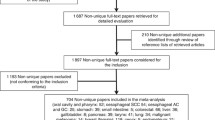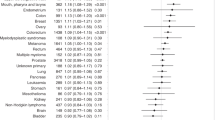Abstract
While alcohol consumption is known to increase the risk of several types of cancer, evidence regarding the association between alcohol and melanoma is inconclusive. This pooled analysis was conducted to examine total alcohol consumption (grams per day), and type of alcohol consumed (beer, wine, beer and wine combined, and liquor) in relation to melanoma among women using original data from eight completed case–control studies (1886 cases and 2113 controls), with adjustment for the potential confounding effects of sun exposure-related factors. We found a positive association with ever consuming alcohol [adjusted pooled odds ratio (pOR) 1.3, 95 % confidence interval (CI) 1.1–1.5]. Specifically the pORs were 1.4 (95 % CI 1.1–1.8) for wine, 1.1 (95 % CI 0.9–1.5) for beer and 1.2 (95 % CI 1.0–1.4) for liquor. However, the pOR for the highest fourth of consumption compared with never consumption was 1.0 (95 % CI 0.7–1.3) without evidence of a trend with increasing amount of total alcohol, or separately with amount of beer, wine or liquor consumed. Stratifying by anatomic site of lesion, number of nevi, age group, or histologic subtype did not alter these results. Although the results showed a weak positive association between ever consuming alcohol and melanoma occurrence, our findings do not provide strong support for the hypothesis that alcohol consumption plays a role in the development of melanoma in women.
Similar content being viewed by others
References
Australian Institute of Health and Welfare (AIHW), Australasian Association of Cancer Registries (AACR) (2012) Cancer in Australia: an overview, vol Cancer series no. 74. Cat. no. CAN 70. AIHW, Canberra
Bataille V, Bishop J, Sasieni P, Swerdlow A, Pinney E, Griffiths K, Cuzick J (1996) Risk of cutaneous melanoma in relation to the numbers, types and sites of naevi: a case-control study. Br J Cancer 73:1605–1611
Bliss JM, Ford D, Swerdlow AJ, Armstrong BK, Cristofolini M, Elwood JM, Green A, Holly EA, Mack T, MacKie RM (1995) Risk of cutaneous melanoma associated with pigmentation characteristics and freckling: systematic overview of 10 case-control studies. The International Melanoma Analysis Group (IMAGE). Int J Cancer 62:367–376
Boniface S, Shelton N (2013) How is alcohol consumption affected if we account for under-reporting? A hypothetical scenario. Eur J Public Health 23:1076–1081. doi:10.1093/eurpub/ckt016
Dosemeci M, Wacholder S, Lubin JH (1990) Does nondifferential misclassification of exposure always bias a true effect toward the null value? Am J Epidemiol 132:746–748
Elwood JM, Whitehead SM, Davison J, Stewart M, Galt M (1990) Malignant melanoma in England: risks associated with naevi, freckles, social class, hair colour, and sunburn. Int J Epidemiol 19:801–810. doi:10.1093/ije/19.4.801
Ferlay J, Soerjomataram I, Ervik M, Dikshit R, Eser S, Mathers C, Rebelo M, Parkin D, Forman D, Bray F (2013) GLOBOCAN 2012 v1.0, Cancer Incidence and Mortality Worldwide: IARC CancerBase No. 11. International Agency for Research on Cancer. http://globocan.iarc.fr. Accessed 03 March 2015
Fone DL, Farewell DM, White J, Lyons RA, Dunstan FD (2013) Socioeconomic patterning of excess alcohol consumption and binge drinking: a cross-sectional study of multilevel associations with neighbourhood deprivation. BMJ Open. doi:10.1136/bmjopen-2012-002337
Ford D, Bliss JM, Swerdlow AJ, Armstrong BK, Franceschi S, Green A, Holly EA, Mack T, Mackie RM, Østerlind A, Walter SD, Peto J, Easton DF (1995) Risk of cutaneous melanoma associated with a family history of the disease. Int J Cancer 62:377–381. doi:10.1002/ijc.2910620403
Gallagher R, Elwood J, Hill G, Coldman A, Threlfall W, Spinelli J (1985) Reproductive factors, oral contraceptives and risk of malignant melanoma: western Canada Melanoma Study. Br J Cancer 52:901–907
Giovannucci E, Stampfer MJ, Colditz GA, Manson JE, Rosner BA, Longnecker MP, Speizer FE, Willett WC (1993) Recall and selection bias in reporting past alcohol consumption among breast cancer cases. Cancer Causes Control 4:441–448
Green A, Bain C (1985) Hormonal factors and melanoma in women. Med J Aust 142:446–448
Harrison RA, Haque AU, Roseman JM, Soong S-J (1998) Socioeconomic characteristics and melanoma incidence. Ann Epidemiol 8:327–333. doi:10.1016/S1047-2797(97)00231-7
Hausauer AK, Swetter SM, Cockburn MG, Clarke CA (2011) Increases in melanoma among adolescent girls and young women in California: trends by socioeconomic status and UV radiation exposure. Arch Dermatol 147:783–789. doi:10.1001/archdermatol.2011.44
Holland B, Welch AA, Unwin ID, Buss DH, Paul AA, Southgate DAT (1991) McCance and Widdowson’s The Composition of Foods, 5th edn. Cambridge
Holly EA, Cress RD, Ahn DK (1995) Cutaneous melanoma in women. III. Reproductive factors and oral contraceptive use. Am J Epidemiol 141:943–950
Holman CD, Armstrong BK, Heenan PJ (1984) Cutaneous malignant melanoma in women: exogenous sex hormones and reproductive factors. Br J Cancer 50:673–680
Idorn LW, Wulf HC (2014) Socioeconomic status and cutaneous malignant melanoma in Northern Europe. Br J Dermatol 170:787–793. doi:10.1111/bjd.12800
International Agency for Research on Cancer (IARC) (2012) Radiation: a review of human carcinogens, vol. 100D. The International Agency for Research on Cancer, Lyon, France
Karagas MR, Stukel TA, Dykes J, Miglionico J, Greene MA, Carey M, Armstrong B, Elwood JM, Gallagher RP, Green A, Holly EA, Kirkpatrick CS, Mack T, Osterlind A, Rosso S, Swerdlow AJ (2002) A pooled analysis of 10 case-control studies of melanoma and oral contraceptive use. Br J Cancer 86:1085–1092
Kirkpatrick CS, White E, Lee JAH (1994) Case-control study of malignant melanoma in Washington State: II. diet, alcohol, and obesity. Am J Epidemiol 139:869–880
Klatsky AL (2008) Invited commentary: never, or hardly ever? It could make a difference. Am J Epidemiol 168:872–875. doi:10.1093/aje/kwn192
Kubo J, Henderson M, Desai M, Wactawski-Wende J, Stefanick M, Tang J (2014) Alcohol consumption and risk of melanoma and non-melanoma skin cancer in the Women’s Health Initiative. Cancer Causes Control 25:1–10. doi:10.1007/s10552-013-0280-3
Langholz B, Richardson J, Rappaport E, Waisman J, Cockburn M, Mack T (2000) Skin characteristics and risk of superficial spreading and nodular melanoma (United States). Cancer Causes Control 11:741–750. doi:10.1023/A:1008952219416
Liu S, Serdula MK, Byers T, Williamson DF, Mokdad AH, Flanders WD (1996) Reliability of alcohol intake as recalled from 10 years in the past. Am J Epidemiol 143:177–186
MacKie RM, Hole DJ (1996) Incidence and thickness of primary tumours and survival of patients with cutaneous malignant melanoma in relation to socioeconomic status. BMJ 312:1125–1128. doi:10.1136/bmj.312.7039.1125
Østerlind A, Tucker MA, Stone BJ, Jensen OM (1988) The Danish case-control study of cutaneous malignant melanoma. IV. No association with nutritional factors, alcohol, smoking or hair dyes. Int J Cancer 42:825–828. doi:10.1002/ijc.2910420604
Roerecke M, Greenfield TK, Kerr WC, Bondy S, Cohen J, Rehm J (2011) Heavy drinking occasions in relation to ischaemic heart disease mortality—an 11–22 year follow-up of the 1984 and 1995 US National Alcohol Surveys. Int J Epidemiol 40:1401–1410. doi:10.1093/ije/dyr129
Rota M, Pasquali E, Bellocco R, Bagnardi V, Scotti L, Islami F, Negri E, Boffetta P, Pelucchi C, Corrao G, La Vecchia C (2014) Alcohol drinking and cutaneous melanoma risk—a systematic review and dose-risk meta-analysis. Br J Dermatol 170:1021–1028. doi:10.1111/bjd.12856
Saladi RN, Nektalova T, Fox JL (2010) Induction of skin carcinogenicity by alcohol and ultraviolet light. Clin Exp Dermatol 35:7–11. doi:10.1111/j.1365-2230.2009.03465.x
Schmidt LA, Mäkelä P, Rehm J, Room R (2010) Alcohol: equity and social determinants. In: Blas E, Kurup AS (eds) Equity, social determinants and public health programmes. WHO Press, Switzerland, pp 11–30
Smith MA, Fine JA, Barnhill RL, Berwick M (1998) Hormonal and reproductive influences and risk of melanoma in women. Int J Epidemiol 27:751–757. doi:10.1093/ije/27.5.751
Stukel TA, Demidenko E, Dykes J, Karagas MR (2001) Two-stage methods for the analysis of pooled data. Stat Med 20:2115–2130. doi:10.1002/sim.852
Swerdlow AJ, English J, MacKie RM, O’Doherty CJ, Hunter JA, Clark J, Hole DJ (1986) Benign melanocytic naevi as a risk factor for malignant melanoma. Br Med J (Clin Res Ed) 292:1555–1559
U.S. Department of Agriculture. Agricultural Research Service (1998) USDA National Nutrient Database for Standard Reference. Nutrient Data Laboratory Home Page. http://www.ars.usda.gov/nuteintdata Release 12
van der Pols JC (2014) Alcoholic drinks and skin cancer–boozing on the beach and beyond. Br J Dermatol 171:1295–1296. doi:10.1111/bjd.13456
Wilkens LR, Hankin JH, Yoshizawa CN, Kolonel LN, Lee J (1992) Comparison of long-term dietary recall between cancer cases and noncases. Am J Epidemiol 136:825–835. doi:10.1093/aje/136.7.825
Willet W (1998) Nutritional Epidemiology, 2nd edn. Oxford University Press, New York
World Cancer Research Fund/American Institute of Cancer Research (2007) Food, nutrition, physical activity, and the prevention of cancer: a global perspective. American Institute of Cancer Research (AICR), Washington, DC
Zanetti R, Franceschi S, Rosso S, Bidoli E, Colonna S (1990) Cutaneous malignant melanoma in females: the role of hormonal and reproductive factors. Int J Epidemiol 19:522–526
Acknowledgments
The IMAGE group members are: Bruce Armstrong, Veronique Bataille, Marianne Berwick, J Mark Elwood, Richard P Gallagher, Adèle C Green, Elizabeth A Holly, Margaret R Karagas, Connie S Kirkpatrick, Thomas Mack, Anne Østerlind, Stephano Rosso, and Anthony J Swerdlow.
This study was supported by the National Institutes of Health, National Cancer Institute R01 CA62345. KM was supported by a National Health and Medical Research Council of Australia (NHMRC) Program Grant (No. 552429). EAH was supported by National Cancer Institute grant R01-CA34382. MRK was supported by the National Institutes of General Medicine grant P20 GM104416. The funders had no role in study design, data collection and analysis, decision to publish, or preparation of the manuscript.
Author information
Authors and Affiliations
Corresponding author
Ethics declarations
Conflict of interest
The authors declare that they have no conflict of interest.
Ethical approval
For this type of study formal consent is not required.
Additional information
On behalf of the International Melanoma Analysis Group (IMAGE) authors. Members of International Melanoma Analysis Group (IMAGE) are listed in “Acknowledgments”.
Electronic supplementary material
Below is the link to the electronic supplementary material.
Rights and permissions
About this article
Cite this article
Miura, K., Zens, M.S., Peart, T. et al. Alcohol consumption and risk of melanoma among women: pooled analysis of eight case–control studies. Arch Dermatol Res 307, 819–828 (2015). https://doi.org/10.1007/s00403-015-1591-x
Received:
Revised:
Accepted:
Published:
Issue Date:
DOI: https://doi.org/10.1007/s00403-015-1591-x




